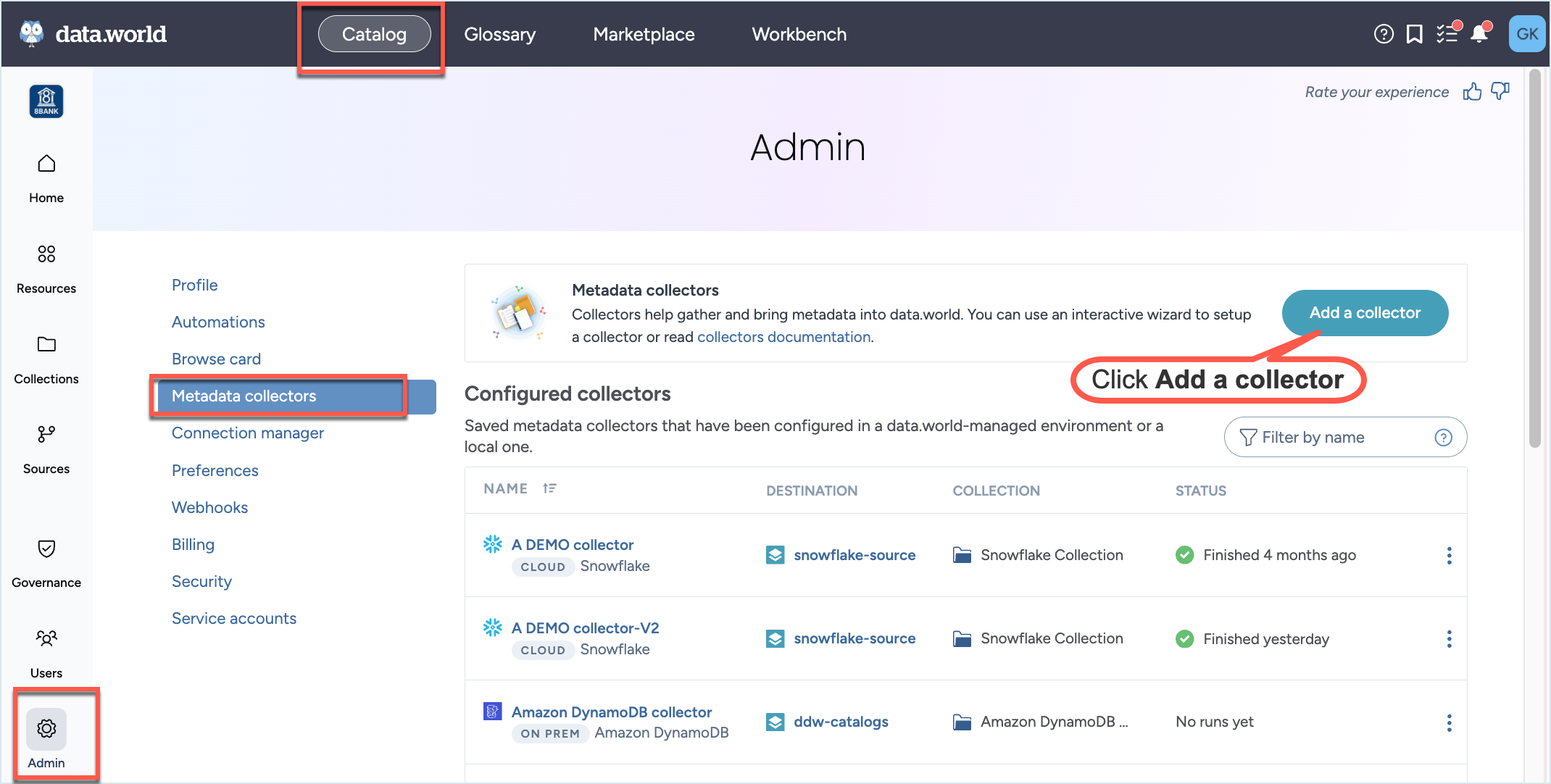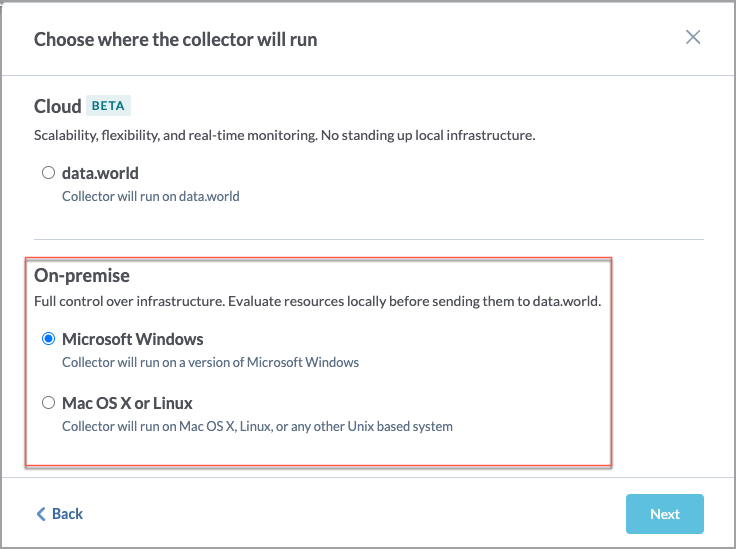Running the Grafana collector on-premise
Generating the command or YAML file
This section walks you through the process of generating the command or YAML file for running the collector from Windows or Linux or MAC OS.
To generate the command or YAML file:
In the Catalog experience, go to the Admin page > Metadata collectors section.
Click the Add a collector button.

On the Choose metadata collector screen, select the correct metadata source. Click Next.
On the Choose where the collector will run screen, in the On-premise section, select if you will be running the collector on Windows or Mac OS or Linux. This will determine the format of the YAML and CLI that is generated in the end. Click Next.

On the On-prem collector setup prerequisites screen, read the pre-requisites and click Next.
On the Configure an on-premises Grafana Collector screen, set the following properties and click Next.
On the next screen, set the following properties and click Next.
Table 2.Field name
Corresponding parameter name
Description
Required?
Base URL of the Grafana API
--grafana-api-base-url= <baseUrl>
Base URL of the Grafana API. Format: https://organizationName.grafana.net/api
Yes
Authentication token
--grafana-api-token= <token>
The token for authentication to the Grafana API. This is the token you generated in this task.
Yes
On the next screen, provide the Collector configuration name and an optional Configuration description. This is the name used to save the configuration details. The configuration is saved and made available on the Metadata collectors summary page from where you can edit or delete the configuration at a later point. Click Save and Continue.
On the Finalize your collector configuration screen, you are notified about the environment variables and directories you need to setup for running the collector. Select if you want to generate Configuration file ( YAML) or Command line arguments (CLI). Click Next.
Important
You must ensure that you have set up these environment variables and directories before you run the collector.
The next screens gives you an option to download the YAML configuration file or copy the CLI command.
If you selected Command line arguments (CLI), from the Choose how to run the collector dropdown, select Java command or Docker command and note down the generated command. Click Done.
If you selected Configuration file ( YAML), download the generated a YAML file. Click Next.
The final screen displays the command to use for running the collector with the YAML file. From the Choose how to run the collector dropdown, select Java command or Docker command, and note down the generated command.
You will notice that the YAML/CLI has following additional parameters that are automatically set for you.
Warning
Except for the collector version, you should not change the values of any of the parameter listed here.
Table 3.Parameter name
Details
Required?
-a= <agent>
--agent= <agent>
--account= <agent>
The ID for the data.world account into which you will load this catalog - this is used to generate the namespace for any URIs generated.
Yes
--site= <site>
This parameter should be set only for Private instances. Do not set it for public instances and single-tenant installations. Required for private instance installations.
Yes (required for private instance installations)
-U
--upload
Whether to upload the generated catalog to the organization account's catalogs dataset.
Yes
--no-log-upload
Do not upload the log of the collector run to a dataset in data.world. This is the same dataset where the collector output is uploaded. By default, log files are uploaded to this dataset.
Yes
dwcc: <CollectorVersion>
The version of the collector you want to use (For example,
datadotworld/dwcc:2.248)Yes
Add the following additional parameter to test run the collector.
--dry-run: If specified, the collector does not actually harvest any metadata, but just checks the connection parameters provided by the user and reports success or failure at connecting.
We recommend enabling debug level logs when running the collector for the first time. This approach aids in swiftly troubleshooting any configuration and connection issues that might arise during collector runs. Add the following parameter to your collector command:
-e log_level=DEBUG: Enables debug level logging for collectors.
Verifying environment variables and directories
Verify that you have set up all the required environment variables that were identified by the Collector Wizard before running the collector. Alternatively, you can set these credentials in a credential vault and use a script to retrieve those credentials.
Verify that you have set up all the required directories that were identified by the Collector Wizard.
Running the collector
Important
Before you begin running the collector make sure you have completed all the pre-requisite tasks.
Running collector using YAML file
Go to the machine where you have setup docker to run the collector.
Place the YAML file generated from the Collector wizard to the correct directory.
From the command line, run the command generated from the application for executing the YAML file. Here is a sample Docker command. Similarly, you can get the Java command from the UI.
Caution
Note that is just a sample command for showing the syntax. You must generate the command specific to your setup from the application UI.
docker run -it --rm --mount type=bind,source=${HOME}/dwcc,target=/dwcc-output \ --mount type=bind,source=${HOME}/dwcc,target=/app/log --mount type=bind,source=${HOME}/dwcc-drivers,target=/usr/src/dwcc-config/lib \ datadotworld/dwcc:2.124 catalog-grafana --agent=8bank-catalog-sources \ --site=solutions --no-log-upload=false --upload=true --api-token=${DW_AUTH_TOKEN} \ --name=8bank-catalog-sources-collection --output=/dwcc-output \ --upload-location=ddw-catalogs --grafana-api-base-url=https://8Bank.grafana.net/api \ --grafana-api-token=${DW_GRAFANA_TOKEN}The collector automatically uploads the file to the specified dataset and you can also find the output at the location you specified while running the collector. Similarly, the log files are uploaded to the specified dataset and can be found in the directory mounted to target=/app/log specified in the command.
If you decide in the future that you want to run the collector using an updated version, simply modify the collector version in the provided command. This will allow you to run the collector with the latest version.
Running collector without the YAML file
Go to the machine where you have setup docker to run the collector.
From the command line, run the command generated from the application. Here is a sample Docker command. Similarly, you can get the Java command from the UI.
Caution
Note that is just a sample command for showing the syntax. You must generate the command specific to your setup from the application UI.
docker run -it --rm --mount type=bind,source=${HOME}/dwcc,target=/dwcc-output \ --mount type=bind,source=${HOME}/dwcc,target=/app/log --mount type=bind,source=${HOME}/dwcc-drivers,target=/usr/src/dwcc-config/lib \ -e DW_AUTH_TOKEN=${DW_AUTH_TOKEN} -e DW_GRAFANA_TOKEN=${DW_GRAFANA_TOKEN} \ datadotworld/dwcc:2.124 --config-file=/dwcc-output/config-grafana.ymlThe collector automatically uploads the file to the specified dataset and you can also find the output at the location you specified while running the collector. Similarly, the log files are uploaded to the specified dataset and can be found in the directory mounted to target=/app/log specified in the command.
If you decide in the future that you want to run the collector using an updated version, simply modify the collector version in the provided command. This will allow you to run the collector with the latest version.
Collector runtime and troubleshooting
The catalog collector may run in several seconds to many minutes depending on the size and complexity of the system being crawled.
If the catalog collector runs without issues, you should see no output on the terminal, but a new file that matching *.dwec.ttl should be in the directory you specified for the output.
If there was an issue connecting or running the catalog collector, there will be either a stack trace or a *.log file. Both of those can be sent to support to investigate if the errors are not clear.
A list of common issues and problems encountered when running the collectors is available here.
Automating updates to your metadata catalog
Maintaining an up-to-date metadata catalog is crucial and can be achieved by employing Azure Pipelines, CircleCI, or any automation tool of your preference to execute the catalog collector regularly.
There are two primary strategies for setting up the collector run times:
Scheduled: You can configure the collector according to the anticipated frequency of metadata changes in your data source and the business need to access updated metadata. It's necessary to account for the completion time of the collector run (which depends on the size of the source) and the time required to load the collector's output into your catalog. This could be for instance daily or weekly. We recommend scheduling the collector run during off-peak times for optimal performance.
Event-triggered: If you have set up automations that refresh the data in a source technology, you can set up the collector to execute whenever the upstream jobs are completed successfully. For example, if you're using Airflow, Github actions, dbt, etc., you can configure the collector to automatically run and keep your catalog updated following modifications to your data sources.
Managing collector runs and configuration details
From the Metadata collectors summary page, view the collectors runs to ensure they are running successfully,
From the same Metadata collectors summary page you can view, edit, or delete the configuration details for the collectors.